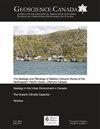Albert Peter Low in Labrador— A Tale of Iron and Irony
IF 0.8
4区 地球科学
Q3 GEOSCIENCES, MULTIDISCIPLINARY
引用次数: 1
Abstract
In 1893–1894, Albert Peter Low of the Geological Survey of Canada, along with D.I.V. Eaton and four indigenous assistants explored the Labrador Peninsula, then perceived as one of the last great unexplored wilderness areas of North America. The expedition left Lake St. John (now Lac St. Jean) on June 17, 1893, canoeing across the northeastern edge of the North American continent, arriving at Fort Chimo (now Kuujjuaq) on August 27, 1893. They departed Fort Chimo by steamer for Rigolet on the Labrador coast and the Hudson Bay Company post at North West River in the fall of 1893. On March 6, 1894 the party started up the Grand (now Churchill) River continuing through large central lakes into the Ashuanipi river system in western Labrador, then out via the Attikonak River to the Romaine River and finally the Saint Jean river system to arrive at Mingan on the north shore of the St. Lawrence River on August 23, 1894. Low described their fifteen-month journey as having covered over 8700 km including 1600 km on foot, over 4700 km in canoe, 800 km by dog team and 1600 km by steamer. The report from the expedition provides a compendium on the natural history of the region as well as the first geological maps. In terms of economic and scientific results, the greatest was documentation of the vast iron ore deposits of western Labrador; a world-class mining district that has been producing for sixty-three years since 1954. Low’s account also provides details on the essence of such an epic journey, which stands as a classic in the annals of Canadian geological surveying.RESUMEEn 1893–1894, Albert Peter Low de la Commission geologique du Canada, accompagne du D.I.V. Eaton et quatre assistants autochtones ont explore la peninsule du Labrador, alors percue comme l'une des dernieres grandes etendues sauvages inexplorees d’Amerique du Nord. L’equipe a quitte le Lake St. John (aujourd'hui le lac Saint-Jean) le 17 juin 1893, a traverse la bordure nord-est du continent nord-americain en canoe, et est arrive a Fort Chimo (aujourd'hui Kuujjuaq) le 27 aout 1893. A l'automne de 1893, ils ont quitte Fort Chimo a bord d'un vapeur pour Rigolet, sur la cote du Labrador, et le poste de la Compagnie de la Baie d'Hudson sur la riviere North West. Le 6 mars 1894, les membres de l'equipe ont remonte la riviere Grand (aujourd'hui Churchill), puis a travers les grands lacs centraux jusqu'au bassin de la riviere Ashuanipi, dans l'ouest du Labrador, puis, par la riviere Attikonak jusqu' a la riviere Romaine et, enfin, le reseau de la riviere Saint-Jean jusqu’a Mingan, sur la rive nord du fleuve Saint-Laurent, le 23 aout 1894. L’excursion decrite par Low a dure quinze mois et parcouru plus de 8700 km dont 1600 km a pied, plus de 4700 km en canoe, 800 km en attelage de chiens et 1600 km en bateau a vapeur. Le rapport de l'expedition constitue un recueil sur l'histoire naturelle de la region ainsi que des premieres cartes geologiques. En ce qui concerne les repercussions economiques et scientifiques, la plus importante en a ete la documentation des vastes gisements de minerai de fer de l'ouest du Labrador, un district minier de classe mondiale, en production pendant soixante-trois ans depuis 1954. Le recit de Low fournit egalement des details sur le caractere epique d’une telle expedition, laquelle est un classique dans les annales de la Commission geologique du Canada.阿尔伯特·彼得·洛在《拉布拉多》中——铁与讽刺的故事
1893年至1894年,加拿大地质调查局的阿尔伯特·彼得·洛(Albert Peter Low)与D.I.V.伊顿(D.I.V.Eaton)和四名土著助手一起探索了拉布拉多半岛,后来被认为是北美最后一个未开发的荒野地区之一。1893年6月17日,远征队离开圣约翰湖(现在的圣约翰湖),划独木舟穿越北美大陆东北边缘,于1893年8月27日抵达奇莫堡(现在的Kuujjuaq)。1893年秋天,他们乘坐轮船前往拉布拉多海岸的里戈莱和西北河的哈德逊湾公司哨所。1894年3月6日,党开始沿着大河(现在的丘吉尔河)继续穿过大型中央湖泊进入拉布拉多西部的阿舒阿尼皮河系统,然后通过阿提科纳克河进入罗曼河,最后圣约翰河系统于1894年8月23日抵达圣劳伦斯河北岸的明安。Low描述了他们15个月的行程,包括步行1600公里、独木舟4700公里、狗队800公里和轮船1600公里。探险队的报告提供了该地区自然历史简编以及第一张地质地图。就经济和科学结果而言,最大的记录是拉布拉多西部的大型铁矿床;自1954年以来63年来一直在生产的世界级矿区。Low的账户还提供了这一史诗之旅本质的详细信息,这是加拿大地质调查年鉴中的经典之旅。1893年至1894年,加拿大地质调查局的阿尔伯特·彼得·洛(Albert Peter Low)与伊顿博士(D.I.V.Eaton)和四名土著助手一起探索了拉布拉多半岛,该半岛当时被认为是北美最后一大片未开发的荒野之一。团队于1893年6月17日离开圣约翰湖(现在的圣约翰湖),乘坐独木舟穿越北美大陆的东北边缘,并于1893月27日抵达奇莫堡(现在的库朱亚克)。1893年秋天,他们乘坐汽船离开奇莫堡前往拉布拉多海岸的里戈莱和西北河上的哈德逊湾公司哨所。1894年3月6日,团队成员沿着大河(现在的丘吉尔河),穿过五大湖中部,到达拉布拉多西部的阿舒阿尼皮河流域,然后沿着阿提科纳克河到达罗马河,最后于1894年8月23日从圣约翰河到圣劳伦斯河北岸的明安。Low A描述的游览持续15个月,行程超过8700公里,包括步行1600公里、独木舟4700公里、狗拉800公里和蒸汽船1600公里。探险队的报告收集了该地区的自然历史和第一张地质地图。关于经济和科学影响,最重要的是记录了拉布拉多西部的大量铁矿床,这是一个世界级的矿区,自1954年以来已经生产了63年。Low的叙述还详细介绍了这次探险的史诗性质,这是加拿大地质调查局编年史上的经典。
本文章由计算机程序翻译,如有差异,请以英文原文为准。
求助全文
约1分钟内获得全文
求助全文
来源期刊

Geoscience Canada
地学-地球科学综合
CiteScore
3.30
自引率
0.00%
发文量
9
审稿时长
>12 weeks
期刊介绍:
Established in 1974, Geoscience Canada is the main technical publication of the Geological Association of Canada (GAC). We are a quarterly journal that emphasizes diversity of material, and also the presentation of informative technical articles that can be understood not only by specialist research workers, but by non-specialists in other branches of the Earth Sciences. We aim to be a journal that you want to read, and which will leave you better informed, rather than more confused.
 求助内容:
求助内容: 应助结果提醒方式:
应助结果提醒方式:


